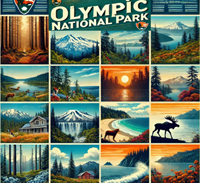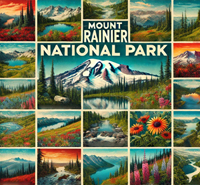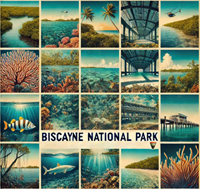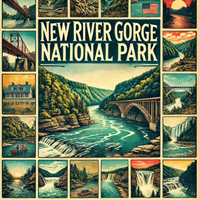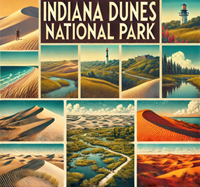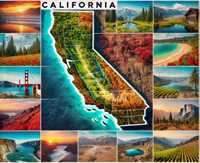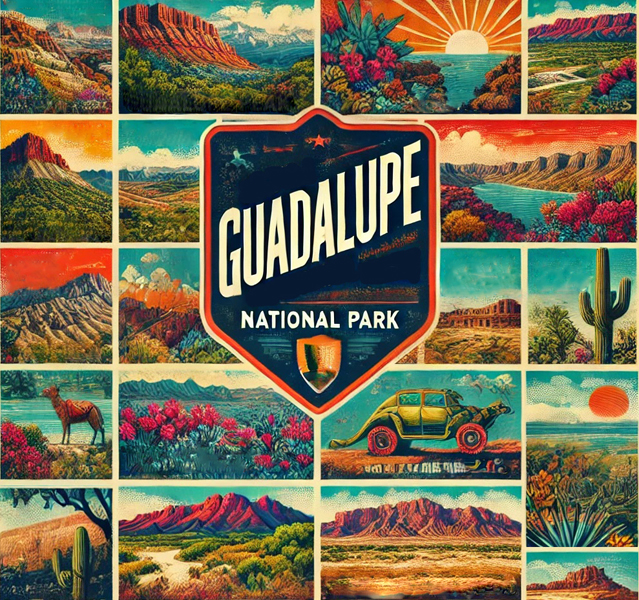
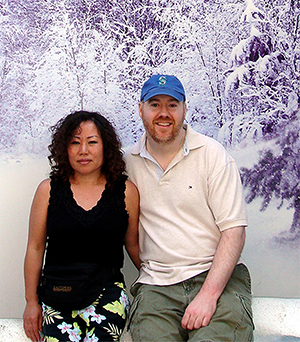
Embark on a journey curated by seasoned explorers William and Hui Cha Stanek, who have spent decades immersing themselves in the diverse landscapes of North America. These itineraries are more than just travel plans - they are thoughtfully crafted adventures designed to help you connect with the natural world, discover hidden gems, and create lasting memories.
National Parks Index | US Itineraries Index | American Roadtrips Index

Bring home a Bugville Critters book and watch as your child's love for reading and learning grows with every page. Hand-painted illustrations bring the heartwarming stories to life. Ask your librarian to add Bugville Critters to the library's digital collection today!
Discover William Stanek's Exclusive Art Collection
Explore and purchase the stunning art featured on this site. Own a piece of William Stanek's unique and captivating artwork today!
(May 2, 2025) Exploring Guadalupe Mountains National Park and Carlsbad Caverns National Park: Texas and New Mexico's Hidden Treasures
Introduction: A 2-Day Journey into the Heart of the Desert Southwest
The desert has always been a place of mystery and allure for us. Its stark beauty, vast landscapes, and hidden wonders beckon the adventurer in all of us. Nestled in the arid expanses of West Texas and southeastern New Mexico, Guadalupe Mountains National Park and Carlsbad Caverns National Park offer a journey into some of the most stunning and surprising landscapes in the Southwest.
Our adventure began with an early morning drive through the rugged terrain of West Texas, where the peaks of the Guadalupe Mountains loomed in the distance like sentinels guarding a forgotten world. This area is home to some of the highest peaks in Texas, including the iconic El Capitan and Guadalupe Peak, which rises to 8,751 feet above sea level. The park is a haven for hikers, with trails that wind through canyons, ascend steep ridges, and traverse the remnants of an ancient seabed.
A short drive to the north, Carlsbad Caverns National Park offers a completely different experience. Here, the wonders are hidden underground, in a vast labyrinth of caves and tunnels that have been slowly carved out by the forces of nature over millions of years. The caverns are a world unto themselves, filled with towering stalagmites, delicate stalactites, and otherworldly formations that seem to defy explanation.
Join us as we take you on a journey through these two remarkable parks. We'll share our stories, tips, and insights to help you create your own unforgettable experiences in Texas and New Mexico's hidden treasures.
Day 1: The Majestic Peaks of Guadalupe Mountains National Park
Morning: Sunrise at Guadalupe Peak
Overview
Start your adventure with a sunrise hike to Guadalupe Peak, the highest point in Texas. This challenging hike offers breathtaking views of the surrounding desert and mountains, with the reward of standing atop the Lone Star State at 8,751 feet above sea level.
Tips from William
"To catch the sunrise from the summit, start your hike around 2:00 AM. The trail is strenuous, but the views from the top are worth every step. Bring a headlamp for the early morning ascent, and a wide-angle lens to capture the expansive views from the summit. The first light of day is perfect for photography, casting a warm glow over the landscape."
Insights from Hui Cha
"There's something incredibly peaceful about hiking under the stars, with only the sound of your footsteps and the occasional rustle of wildlife to keep you company. The sunrise from Guadalupe Peak is one of those experiences that stays with you – a reminder of the beauty and solitude of the desert."
How to Access Guadalupe Peak
Directions:
- From Pine Springs Visitor Center, follow signs to the Guadalupe Peak trailhead, located in the main parking area.
Trail Details:
- Trail Length: 8.4 miles round-trip
- Elevation Gain: 3,000 feet
- Difficulty: Strenuous
Photography Tips: For the best shots of the sunrise, arrive at the summit well before dawn to set up your camera and find the perfect angle. Use a small aperture (f/16 or smaller) to keep both the foreground and the distant mountains in focus. A wide-angle lens will allow you to capture the full scope of the landscape, and a tripod is essential for stabilizing your camera in the low light.
Alternative Activity: If the hike to Guadalupe Peak is too strenuous, consider hiking the McKittrick Canyon Trail. This trail is less challenging but offers stunning views of the canyon, especially during the fall when the foliage turns vibrant shades of red and gold.
Mid-Morning: Exploring McKittrick Canyon
Overview
After your sunrise hike, head to McKittrick Canyon, often referred to as the "most beautiful spot in Texas." This hike offers a stark contrast to the rugged peaks of Guadalupe Peak, with lush vegetation, colorful foliage, and the clear waters of McKittrick Creek.
Tips from William
"The McKittrick Canyon Trail is one of the best hikes in the park, offering a mix of scenery that's hard to beat. Bring a wide-angle lens to capture the expansive views of the canyon, but also keep a macro lens handy for photographing the colorful foliage and delicate wildflowers. The trail is relatively flat and easy, making it a great option for all skill levels."
Insights from Hui Cha
"McKittrick Canyon feels like an oasis in the desert. The cool shade of the trees, the sound of the creek, and the vibrant colors of the foliage make this a perfect place to relax and enjoy the beauty of the park. I love finding a quiet spot along the trail to sit and take it all in."
How to Access McKittrick Canyon
Directions:
- From Pine Springs Visitor Center, take US-62/180 east for about 7 miles to the McKittrick Canyon turnoff. Follow the road to the trailhead parking area.
Trail Details:
- Trail Length: 7 miles round-trip to the Grotto
- Elevation Gain: 600 feet
- Difficulty: Moderate
Photography Tips: As you hike along the trail, look for opportunities to capture the contrast between the lush greenery of the canyon and the rugged desert landscape beyond. Use a polarizing filter to enhance the colors and reduce glare, especially if you're photographing the creek. For a more creative shot, try framing the canyon with the surrounding trees and foliage.
Alternative Activity: If you prefer a shorter hike, consider exploring the Smith Spring Trail, a 2.3-mile loop that offers beautiful views of the surrounding mountains and desert, as well as a peaceful spring-fed oasis.
Afternoon: Exploring the Salt Basin Dunes
Overview
In the afternoon, take a short drive to the Salt Basin Dunes, a unique and otherworldly landscape located on the western edge of Guadalupe Mountains National Park. These white gypsum dunes offer a stark contrast to the rugged peaks of the park, creating a surreal landscape that's perfect for exploration and photography.
Tips from William
"The Salt Basin Dunes are a photographer's paradise, with endless opportunities to capture the unique patterns and textures of the dunes. Bring a wide-angle lens to capture the full scale of the landscape, but also keep a telephoto lens handy for zooming in on the details of the sand patterns and the surrounding mountains. The best light for photography is in the late afternoon when the sun is low in the sky and the shadows are long."
Insights from Hui Cha
"Walking through the Salt Basin Dunes feels like stepping into another world. The white sand, the deep blue sky, and the distant mountains create a landscape that's both beautiful and surreal. I love taking my time to explore the dunes, finding hidden patterns in the sand and enjoying the peace and solitude of the place."
How to Access the Salt Basin Dunes
Directions:
- From Pine Springs Visitor Center, take US-62/180 west for about 15 miles, then turn left onto FM 1576 and follow signs to the Salt Basin Dunes parking area.
Trail Details:
- Trail Length: 1 mile round-trip to the dunes
- Elevation Gain: Minimal
- Difficulty: Easy
Photography Tips: For the best shots of the dunes, arrive in the late afternoon to capture the warm light and long shadows. Use a wide-angle lens to photograph the sweeping views of the dunes and the surrounding mountains, and a telephoto lens to zoom in on the intricate patterns in the sand. Be sure to experiment with different compositions, focusing on the textures and lines created by the wind.
Alternative Activity: If you prefer to stay closer to the park's main area, consider exploring the Devil's Hall Trail, a 4.2-mile round-trip hike that takes you through a narrow canyon with towering walls and unique rock formations.
Evening: Sunset at El Capitan Viewpoint
Overview
End your day with a visit to the El Capitan Viewpoint, one of the most iconic landmarks in Guadalupe Mountains National Park. This towering peak, which rises to 8,085 feet, is a symbol of the park and a must-see for any visitor.
Tips from William
"El Capitan is a fantastic spot to capture the sunset, with wide, sweeping views of the surrounding desert and mountains. Set up your tripod well before sunset to find the best angle, and use a wide-angle lens to capture the full scene. A graduated neutral density filter will help balance the exposure between the bright sky and the darker landscape."
Insights from Hui Cha
"Sunset at El Capitan is one of the most beautiful experiences you can have in Guadalupe Mountains National Park. The way the light plays across the peak, casting long shadows and turning the rock a deep red, is truly magical. Bring a blanket and a warm drink, and take some time to simply sit and enjoy the moment."
How to Access El Capitan Viewpoint
Directions:
- From Pine Springs Visitor Center, take US-62/180 east for about 5 miles to the El Capitan Viewpoint parking area.
Viewpoint Details:
- Location: Along US-62/180, about 5 miles east of Pine Springs
- Elevation Gain: None (viewpoint is accessible by car)
- Difficulty: Easy
Photography Tips: For a stunning sunset shot, position yourself on the western side of the viewpoint to capture the last light of the day as it illuminates the peak. Use a small aperture (f/16 or smaller) to keep the entire scene in focus, and experiment with different shutter speeds to capture the changing light. If the conditions are right, consider staying after sunset to photograph the stars as they appear.
Alternative Activity: If you prefer a less crowded spot for sunset, consider visiting the nearby Frijole Ranch, where you can explore the historic buildings and enjoy beautiful views of the surrounding landscape.
Conclusion: Reflections on the Day
As the last rays of sunlight faded from the sky and the stars began to emerge, Hui Cha and I stood quietly at El Capitan Viewpoint, reflecting on the incredible journey we had just experienced. From the challenging hike to Guadalupe Peak to the peaceful solitude of McKittrick Canyon and the surreal beauty of the Salt Basin Dunes, each moment had been a reminder of the sheer power and beauty of Guadalupe Mountains National Park.
These moments, spent in the heart of nature, are what make our travels so meaningful. They're a reminder of the importance of preserving these wild places, and of the deep connection we feel to the land. As we packed up our gear and prepared to head back to our campsite, I felt a deep sense of gratitude for the day's experiences and for the time spent in this incredible park.
Our journey through the desert Southwest was far from over. Tomorrow would take us to Carlsbad Caverns National Park, where we would explore the hidden wonders of one of the most impressive cave systems in the world. But for now, we were content to sit beneath the stars, listening to the quiet of the desert and feeling the peace that only comes from being in the heart of the wilderness.
Day 2: The Hidden Wonders of Carlsbad Caverns National Park
Morning: Exploring the Big Room
Overview
Begin your day in Carlsbad Caverns National Park with a tour of the Big Room, the largest single cave chamber by volume in North America. This massive underground space is filled with stunning rock formations, including towering stalagmites, delicate stalactites, and massive columns.
Tips from William
"The Big Room is a photographer's paradise, with endless opportunities to capture the unique formations and intricate details of the cave. Bring a tripod to stabilize your camera in the low light, and a wide-angle lens to capture the full scale of the room. Be sure to experiment with different compositions, focusing on the textures and shapes of the formations."
Insights from Hui Cha
"Walking through the Big Room feels like stepping into another world. The sheer size of the space, combined with the beauty of the formations, creates an atmosphere that's both awe-inspiring and humbling. Take your time as you explore the room, and don't forget to look up – some of the most incredible formations are hanging from the ceiling."
How to Access the Big Room
Directions:
- From the Carlsbad Caverns Visitor Center, take the elevator down to the Big Room or hike in via the Natural Entrance Trail.
Tour Details:
- Tour Length: 1.25 miles (self-guided loop)
- Elevation Gain: Minimal
- Difficulty: Easy
Photography Tips: For the best shots of the Big Room, use a slow shutter speed to capture the low light, and a small aperture (f/16 or smaller) to keep the entire scene in focus. A tripod is essential for stabilizing your camera, and a wide-angle lens will allow you to capture the full scale of the formations. Be sure to experiment with different angles and perspectives to highlight the unique shapes and textures of the cave.
Alternative Activity: If you prefer a more guided experience, consider joining the King's Palace tour, which takes you into a deeper part of the cave and offers a more intimate look at some of the most beautiful formations in the park.
Mid-Morning: Bat Flight Program
Overview
After exploring the Big Room, head to the Bat Flight Amphitheater for the park's Bat Flight Program. Every evening from late spring through early fall, thousands of Mexican free-tailed bats emerge from the cave in a spectacular display as they head out to hunt for insects.
Tips from William
"The Bat Flight Program is one of the most unique experiences in Carlsbad Caverns National Park. Arrive early to get a good spot in the amphitheater, and bring a telephoto lens to capture the bats as they emerge from the cave. The best light for photography is in the early evening, just before sunset."
Insights from Hui Cha
"Watching the bats emerge from the cave is an unforgettable experience. The sight of thousands of bats swirling out of the cave and into the evening sky is both mesmerizing and awe-inspiring. The program is a great way to learn more about these incredible creatures and their role in the ecosystem."
How to Access the Bat Flight Amphitheater
Directions:
- From the Carlsbad Caverns Visitor Center, follow the signs to the Bat Flight Amphitheater, located near the Natural Entrance.
Program Details:
- Program Length: 30 to 45 minutes
- Elevation Gain: None
- Difficulty: Easy
Photography Tips: For the best shots of the bats, use a fast shutter speed to capture their rapid movements, and a telephoto lens to zoom in on the action. The light can be tricky in the evening, so be prepared to adjust your settings as needed. If possible, try to capture the bats against the backdrop of the setting sun for a truly dramatic shot.
Alternative Activity: If you're visiting outside of bat season, consider exploring the Slaughter Canyon Cave on a guided tour. This less-visited cave offers a more adventurous experience, with stunning formations and the opportunity to explore a more rugged part of the park.
Afternoon: Hiking the Walnut Canyon Desert Loop
Overview
In the afternoon, explore the above-ground beauty of Carlsbad Caverns National Park with a hike along the Walnut Canyon Desert Loop. This scenic trail offers beautiful views of the Chihuahuan Desert, with opportunities to see native plants, wildlife, and stunning desert landscapes.
Tips from William
"The Walnut Canyon Desert Loop is a great way to experience the desert environment of Carlsbad Caverns National Park. Bring a wide-angle lens to capture the expansive views of the desert, but also keep a macro lens handy for photographing the delicate desert plants and flowers. The light in the late afternoon is perfect for photography, casting long shadows and adding depth to the landscape."
Insights from Hui Cha
"The desert around Carlsbad Caverns is full of life and beauty. I love the contrast between the harsh, rugged landscape and the delicate plants and flowers that thrive here. The Walnut Canyon Desert Loop is a peaceful hike, offering a chance to connect with the desert and enjoy the quiet beauty of the park."
How to Access the Walnut Canyon Desert Loop
Directions:
- From the Carlsbad Caverns Visitor Center, follow the signs to the Walnut Canyon Desert Loop trailhead, located near the entrance road.
Trail Details:
- Trail Length: 2.2 miles round-trip
- Elevation Gain: 200 feet
- Difficulty: Easy to Moderate
Photography Tips: As you hike along the trail, look for opportunities to capture the contrast between the rugged desert landscape and the delicate desert plants. Use a polarizing filter to enhance the colors and reduce glare, especially in the midday sun. For a more creative shot, try framing the desert landscape with the surrounding cacti and other native plants.
Alternative Activity: If you prefer a shorter hike, consider exploring the Chihuahuan Desert Nature Trail, a 0.5-mile loop that offers a more accessible option with beautiful views of the desert and opportunities to learn about the native plants and animals.
Evening: Sunset at Rattlesnake Springs
Overview
End your day with a visit to Rattlesnake Springs, an oasis in the desert located just outside Carlsbad Caverns National Park. This area is a haven for birdwatchers, with over 300 species of birds recorded, and offers beautiful views of the surrounding desert and mountains.
Tips from William
"Rattlesnake Springs is a fantastic spot to capture the sunset, with wide, sweeping views of the desert and the mountains in the distance. Set up your tripod well before sunset to find the best angle, and use a wide-angle lens to capture the full scene. A telephoto lens is also handy for photographing the birds and other wildlife that frequent the area."
Insights from Hui Cha
"Sunset at Rattlesnake Springs is a peaceful and beautiful way to end the day. The sound of the birds, the cool shade of the trees, and the sight of the sun setting over the desert make this a perfect place to relax and enjoy the beauty of the park. I love finding a quiet spot by the springs to sit and take in the scenery."
How to Access Rattlesnake Springs
Directions:
- From Carlsbad Caverns Visitor Center, take US-62/180 west for about 10 miles, then turn left onto Rattlesnake Springs Road and follow signs to the picnic area.
Viewpoint Details:
- Location: About 10 miles west of Carlsbad Caverns Visitor Center
- Elevation Gain: None (area is accessible by car)
- Difficulty: Easy
Photography Tips: For a stunning sunset shot, position yourself near the springs to capture the reflection of the sky in the water. Use a small aperture (f/16 or smaller) to keep the entire scene in focus, and experiment with different shutter speeds to capture the changing light. If the conditions are right, consider staying after sunset to photograph the stars as they appear.
Alternative Activity: If you prefer a more active way to end the day, consider taking a short hike on the Slaughter Canyon Trail, which offers beautiful views of the surrounding desert and mountains, as well as opportunities to see native wildlife.
Conclusion: A Personal Reflection
As the last rays of sunlight faded from the sky and the stars began to emerge, Hui Cha and I stood quietly at Rattlesnake Springs, reflecting on the incredible journey we had just experienced. From the awe-inspiring formations of the Big Room to the peaceful solitude of the Walnut Canyon Desert Loop, each moment had been a reminder of the sheer power and beauty of Carlsbad Caverns National Park.
These parks are more than just places to visit – they are places to connect with the natural world, to find peace and inspiration, and to create memories that will last a lifetime. As we packed up our gear and prepared to head back to our campsite, I felt a deep sense of gratitude for the time we had spent in these wild, untamed places. They had not only shown us the beauty of the land but had also brought us closer to each other and to the world around us.
Our journey through Texas and New Mexico's hidden treasures had come to an end, but the experiences we had shared would stay with us forever. And as we drove away from the desert, I knew that we would return, drawn back by the promise of new adventures and the chance to explore even deeper into the heart of the Southwest.

Step into a world of timeless beauty with our premium, oversized hardcover book - crafted for discerning collectors and anyone who values the power of art. Perfect for your coffee table, it's more than just a book; it's a conversation starter, a window into over 30 years of William's visionary photography.
Your Support Matters
Purchasing artwork from William Stanek's collection not only brings beauty into your life but also helps us continue to share. Thank you for supporting our creative journey!

Support The Lights of Paris by Robert Stanek, William Stanek's pen name! Through vivid historical detail and deeply moving character stories, Robert takes readers on an unforgettable journey through one of history’s most transformative times.


